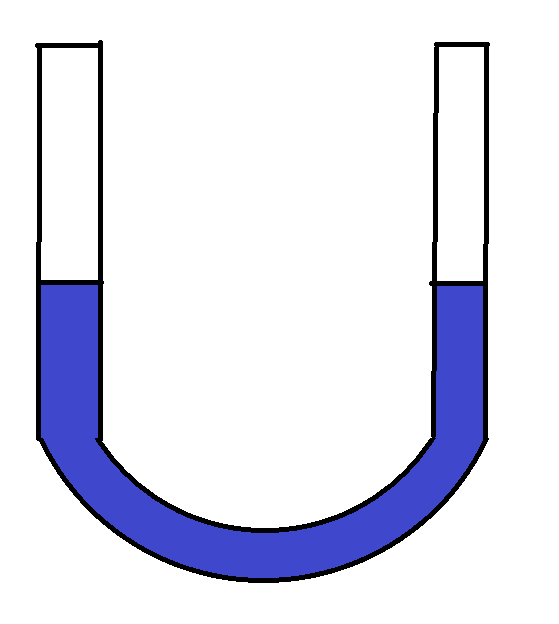
A U-tube is partially filled with water. Oil, which does not mix with water, is next poured into one side until water rises by 25 cm on the other side, if the specific gravity of oil be 0.8, the oil level will stand higher than the water level by:
A. 6.25 cm
B. 12.50 cm
C. 31.25 cm
D. 62.50 cm
Answer
475.5k+ views
Hint: Manometer is a device used for measuring the pressure in liquids. One of the most common types of manometers are called U-tube manometers which consist of a U-shaped tube. The pressure is calculated by measuring the height difference between the two limbs of the manometer.
Complete step by step answer:
Let us consider a U-tube manometer partially filled with water, as shown:

When oil is added to one side, the water on the other limb rises by 25 cm as shown.

Let h be the height to which the oil is filled.
If the level of water in one end rises by 25 cm at point B, the water level in the other end decreases by 25 cm at point A when the oil is added on top of it.
At the points A and B, the pressure will be equal.
Pressure at A = Pressure at B
${P_A} = {P_B}$
Pressure at point A,${P_A} = {\rho _{oil}} \times g \times (h + 25)$
Pressure at point B,${P_B} = {\rho _{water}} \times g \times 25$
Equating, we get –
${\rho _{oil}} \times g \times (h + 25)$= ${\rho _{water}} \times g \times 25$
Given, specific gravity of oil = 0.8
Specific gravity, $\dfrac{{{\rho _{oil}}}}{{{\rho _{water}}}} = 0.8$
\[
{\rho _{oil}} \times{g} \times (h + 25) = {\rho _{water}} \times {g} \times 25 \\
\dfrac{{{\rho _{oil}}}}{{{\rho _{water}}}} \times (h + 25) = 25 \\
Substituting, \\
0.8 \times (h + 25) = 25 \\
\Rightarrow (h + 25) = \dfrac{{25}}{{0.8}} \\
\Rightarrow h + 25 = 31.25 \\
\Rightarrow h = 31.25 - 25 \\
\Rightarrow h = 6.25cm \\
\]
Thus, the correct option is Option A.
Note: When the manometer is used to measure the pressure, the pressure, so recorded, is called absolute pressure. This pressure includes the atmospheric pressure. Now, if we subtract the atmospheric pressure from the absolute pressure, we get something called as gauge pressure.
Complete step by step answer:
Let us consider a U-tube manometer partially filled with water, as shown:

When oil is added to one side, the water on the other limb rises by 25 cm as shown.

Let h be the height to which the oil is filled.
If the level of water in one end rises by 25 cm at point B, the water level in the other end decreases by 25 cm at point A when the oil is added on top of it.
At the points A and B, the pressure will be equal.
Pressure at A = Pressure at B
${P_A} = {P_B}$
Pressure at point A,${P_A} = {\rho _{oil}} \times g \times (h + 25)$
Pressure at point B,${P_B} = {\rho _{water}} \times g \times 25$
Equating, we get –
${\rho _{oil}} \times g \times (h + 25)$= ${\rho _{water}} \times g \times 25$
Given, specific gravity of oil = 0.8
Specific gravity, $\dfrac{{{\rho _{oil}}}}{{{\rho _{water}}}} = 0.8$
\[
{\rho _{oil}} \times{g} \times (h + 25) = {\rho _{water}} \times {g} \times 25 \\
\dfrac{{{\rho _{oil}}}}{{{\rho _{water}}}} \times (h + 25) = 25 \\
Substituting, \\
0.8 \times (h + 25) = 25 \\
\Rightarrow (h + 25) = \dfrac{{25}}{{0.8}} \\
\Rightarrow h + 25 = 31.25 \\
\Rightarrow h = 31.25 - 25 \\
\Rightarrow h = 6.25cm \\
\]
Thus, the correct option is Option A.
Note: When the manometer is used to measure the pressure, the pressure, so recorded, is called absolute pressure. This pressure includes the atmospheric pressure. Now, if we subtract the atmospheric pressure from the absolute pressure, we get something called as gauge pressure.
Recently Updated Pages
One difference between a Formal Letter and an informal class null english null

Can anyone list 10 advantages and disadvantages of friction

What are the Components of Financial System?

How do you arrange NH4 + BF3 H2O C2H2 in increasing class 11 chemistry CBSE

Is H mCT and q mCT the same thing If so which is more class 11 chemistry CBSE

What are the possible quantum number for the last outermost class 11 chemistry CBSE

Trending doubts
The reservoir of dam is called Govind Sagar A Jayakwadi class 11 social science CBSE

What is the chemical name of Iron class 11 chemistry CBSE

The dimensional formula of dielectric strength A M1L1T2Q class 11 physics CBSE

The members of the Municipal Corporation are elected class 11 social science CBSE

What is spore formation class 11 biology CBSE

In China rose the flowers are A Zygomorphic epigynous class 11 biology CBSE




